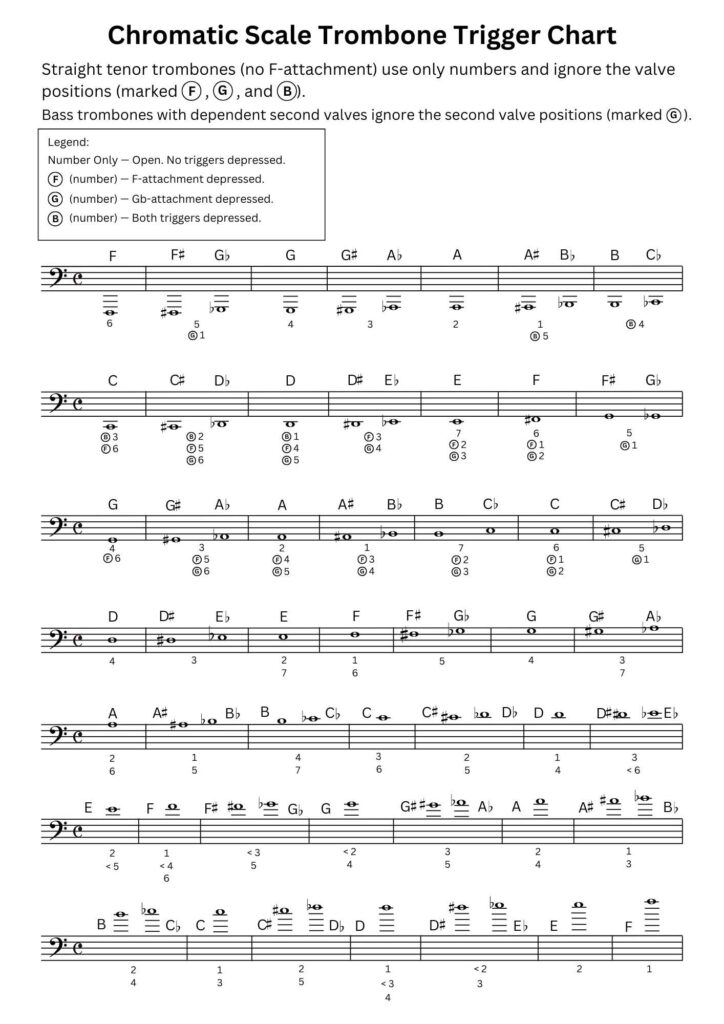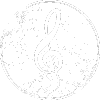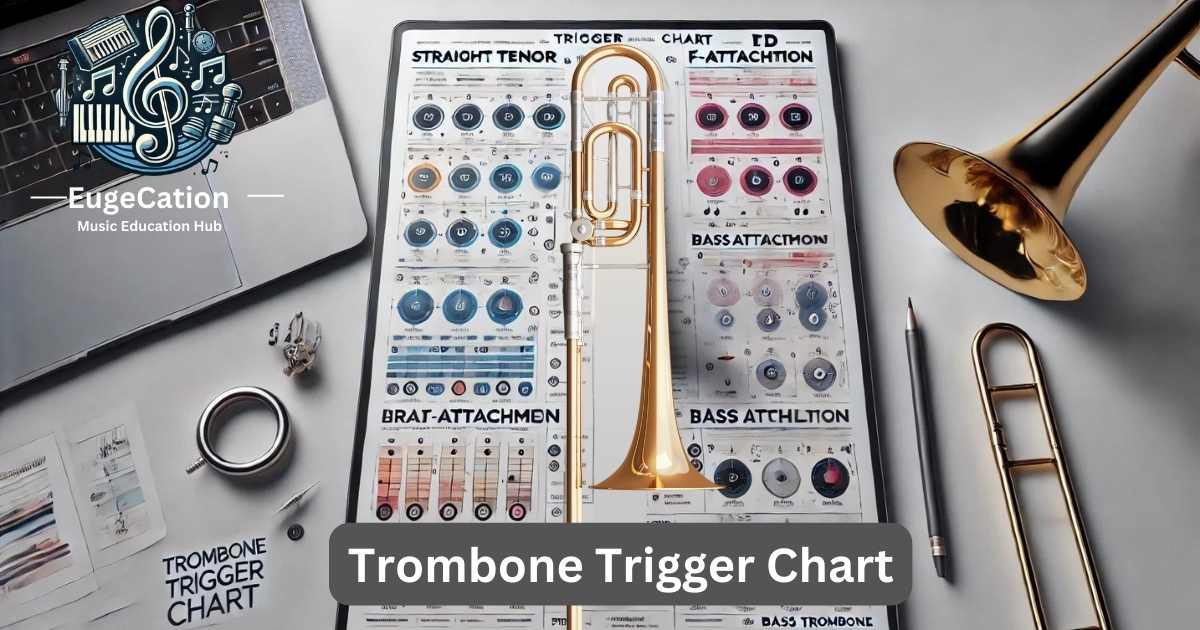Easy Trombone Trigger Chart PDF
Original price was: $0.65.$0.00Current price is: $0.00.
Description
A Trombone Trigger Chart is a reference guide to help you understand the diverse positions and techniques necessary for playing various notes on a Trombone, especially those with a trigger or F-Attachment. These charts represent slide positions and corresponding notes, serving as valuable aids for trombonists to effectively and efficiently navigate the instrument’s range.
With different types of trombones(straight tenor, tenor with F-trigger, or bass), having a tailored trigger chart allows musicians to optimize their playing experience based on their specific instrument. Seamlessly transition between notes and make precise adjustments to achieve desired tones during performances or practice sessions.

Types of Trombone Trigger Charts
Various types of Trombone Trigger Charts are available to cater to the specific requirements of different trombone models, including the Straight Tenor, F-Attachment Trombone, and Bass Trombone.
Straight Tenor Trombone Trigger Chart
A Straight Tenor Trombone Trigger Chart primarily focuses on the slide positions for different notes without using an F-attachment.
This chart serves as a valuable tool for trombone players like yourself who appreciate the simplicity of a straight tenor trombone and wish to avoid the additional weight and complexity of an F-attachment. By presenting a visual representation of the slide positions necessary to produce specific pitches, this chart assists you in quickly and accurately identifying the correct positions on your instrument.
Utilizing this tool is particularly advantageous for honing intonation and ensuring accurate note rendition. It enables you to build muscle memory for each position corresponding to a specific note, ultimately leading to a more polished overall performance.
F-Attachment Trombone Trigger Chart
A Trombone Trigger Chart with an F-Attachment incorporates detailed information to accommodate the additional valve and slide positions, providing increased versatility for playing lower notes and achieving enhanced technical control.
This additional valve on the F-Attachment Trombone Trigger Chart enables players to access extended slide positions, facilitating a seamless transition between notes in the lower register. By taking advantage of these supplementary features, musicians can navigate complex passages more easily and with greater precision.
The F-Attachment Trombone Trigger Chart expands the instrument’s overall range, allowing players to explore a broader spectrum of tones and expressiveness. This innovative design significantly enhances the instrument’s capabilities and unlocks new possibilities for musical expression.
Bass Trombone Trigger Chart
Utilize a Bass Trombone Trigger Chart to navigate the extended range and intricate slide positions necessary for playing a bass trombone effectively.
This chart illustrates the slide positions with two attachments and associated notes, aiding lower registers. By leveraging the trigger chart, musicians achieve precise pitch accuracy and uphold a consistent tone quality during their performances.
This tool equips players to confidently tackle demanding musical passages with clarity, thereby enhancing their musicality and technical proficiency on the bass trombone.
How to Use a Trombone Trigger Chart?
To effectively utilize a Trombone Trigger Chart, you should incorporate it into your routine practice sessions. Utilize it as a valuable learning tool to enhance your slide positions, refine note accuracy, and elevate your overall playing techniques.
Practicing with Scales
Practicing scales with a trombone trigger chart will help you gain familiarity with slide positions and enhance your ability to play notes smoothly and accurately.
Incorporating scale exercises into your daily practice routine can effectively strengthen muscle memory and enhance overall dexterity on the trombone. Beginning with basic major scales and progressively moving to more intricate ones will challenge you to navigate through different positions effortlessly. Using the trigger chart to visualize slide positions corresponding to each note not only aids in memorization but also helps refine intonation and technique.
Consistent and dedicated practice, guided by the trigger chart, is essential for mastering scales and improving your skills as a trombonist.
Playing Songs with the Trigger Chart
Utilizing a trombone trigger chart while playing songs allows you to apply your acquired positions and techniques to actual musical compositions, thereby enhancing your performance abilities.
By consulting the trigger chart, you can accurately determine the necessary notes and positions for each song, optimizing your practice sessions. This approach enables you to concentrate on particular areas that require enhancement, thus boosting your overall performance. Incorporating the trigger chart into your practice routines aids in maintaining precision in note-playing and reinforces your capacity to master challenging sections.
It is important to utilize the chart as a tool for accuracy and consistency, gradually developing your confidence and proficiency with diverse musical pieces.
Tips for Using a Trombone Trigger Chart
Utilizing a Trombone Trigger Chart effectively necessitates implementing practical tips and strategies to optimize the benefits derived from this valuable learning resource, enhancing both your practice sessions and overall performance.
Keeping the Chart Handy
Keep the trigger chart handy during your practice sessions for quick access to it whenever necessary. Have the chart readily available for your practice routine to eliminate interruptions in searching for specific information.
When organizing your practice space, position the chart in a visible location (or use a stand). Employ color-coding (or labeling) techniques to differentiate various sections for easier navigation. Develop a habit of periodically glancing at the chart while playing to solidify muscle memory and monitor important techniques and finger placements.
Using a Metronome
Using a metronome in conjunction with your “trombone trigger chart” maintains proper timing and rhythm, ensuring that your practice sessions are efficient and effective. The metronome acts as a dependable tool for a sense of internal pulse, enabling you to synchronize your playing with dynamics.
To optimize the advantages, commence with slower tempos and gradually accelerate as you become more confident in your timing.
Frequently Asked Questions
What is a trombone trigger chart?
A trombone trigger chart is a visual representation of the different positions or combinations of positions that a trombone player can use to play specific notes on their instrument. It is typically used as a reference guide for players to quickly and easily find the correct positions for different notes.
Why is it helpful to have an easy trombone trigger chart?
Having an easy trombone trigger chart can save time and effort for trombone players, especially when playing complex pieces of music. Instead of having to remember the positions for each note, players can simply refer to the chart for a quick and accurate positioning guide.
What types of trombones can use this trigger chart?
This trigger chart is designed for use with three types of trombones: straight tenor, F-attachment, and bass. Each of these types have their own unique slide positions, and this chart provides a comprehensive guide for all three.
Is the trombone trigger chart suitable for all skill levels?
Yes, this trombone trigger chart is suitable for players of all skill levels, from beginners to professionals. It is a useful tool for beginners to learn the proper positions for notes, and for more experienced players to quickly find the positions for more challenging pieces of music.
Can I download this trombone trigger chart as a PDF?
Yes, this trigger chart is a downloadable PDF for easy access and printing. This allows players to have a physical copy of the chart for practice and performance purposes.
Are there any variations in trombone trigger charts?
Yes, trigger charts may vary slightly depending on the brand or model of a trombone. Check this Yamaha chart.
[Also check “12 Major Trombone Scales” ]
Additional information
| Instrument | Trombone |
|---|---|
| Level | Beginner |
| Type | Sheet Music |






Reviews
There are no reviews yet.